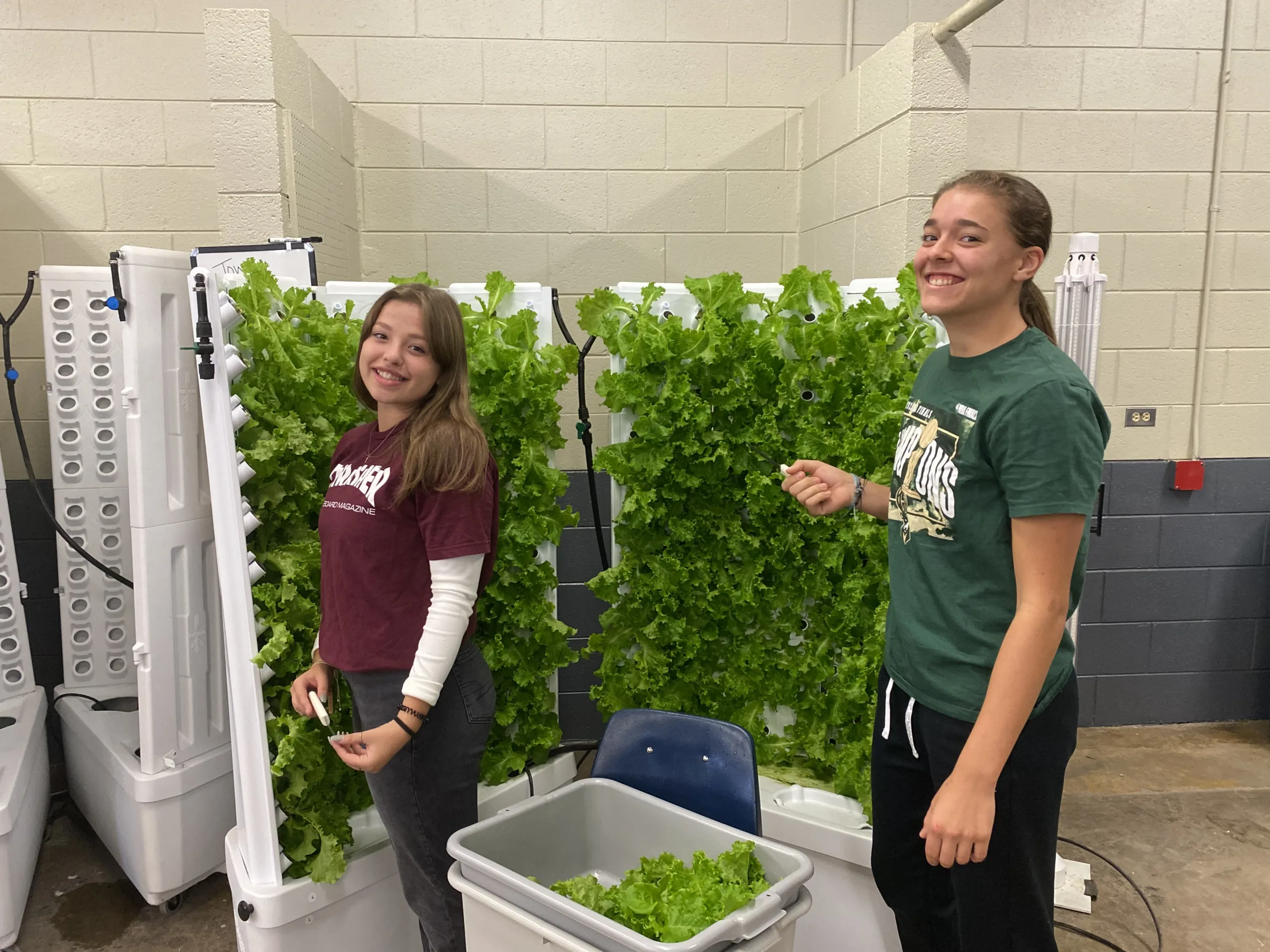
Students take care of four hydroponic towers that grow lettuce at Bloomer High School.
High school junior Jillian Bresina carefully pours white powder into a beaker, then mixes it, like some sort of chemistry experiment.
But Jillian isn’t in science class. She’s in the Bloomer High School shop, where she’s taking a horticulture class.
“I’m dissolving the nutrients, so I can dump it into the water,” Jillian says.
The concoction of water and macronutrients—nitrogen, phosphorus, and potassium—turns green, and Jillian pours it into a water tank.
“Plants outside have soil to get nutrients from,” she says. “These plants don’t have soil, because they’re in a hydroponic tower.”
Jillian dips a digital tester down into the water.
“The nutrient level is 417.”
Mixing it up for hydroponics
Bloomer High School in western Wisconsin is the proud owner of four Flex Farms. Flex Farms are fully self-contained hydroponic growing systems, also called towers, that allow for growing fresh, affordable produce year-round. These vertical, indoor farms create 25 pounds of produce per month, ranging from leafy vegetables to herbs. In Bloomer, students from all the agriscience classes, who are also all Future Farmers of America (FFA) members, are growing lettuce.
As they do, they’re learning important skills that, one day, they might use on their own farms.
“Every day students check the nutrient levels, they check the PH of the water to make sure the plants are going to be healthy in the water, and they’re checking for daily plant care—making sure the plants are healthy, that they’re growing,” said Racheal Haas, agriscience teacher and FFA advisor. “They’re problem solving situations as they arise—maybe the lettuce is starting to wilt, so they’re able to problem solve to make sure it’s growing well.”
Saving the school some money
While students are growing healthy, fresh food in the classroom, other departments are also benefiting. For example, there’s a collaboration with the school’s food service.
“Every week we make a harvest,” Haas said. “The best part about this is that we can get it from our hydroponic system in the morning to the lunch trays in the afternoon, so it’s going directly just down the hall and they prep it and put it out for lunch the same day.”
Investing in the future of food
About 60 miles away in St. Croix County, students at the New Richmond School are in their first year of growing with Flex Farms.
New Richmond’s School Nutrition Director Bobbie Guyette is also the president of the School Nutrition Association of Wisconsin. Just a year ago she made the case to the New Richmond School Board to approve her purchase of six hydroponic growing systems, for a price tag of about $30,000 from her school nutrition budget.
She told the board each tower was capable of growing more than 300 pounds of produce each year at a cost of $1 per pound.
“Investing in these systems reinforces the district’s commitment to advance the use of local foods, and provides an immediate tool to engage students in nutrition education,” Guyette said.
Most of their towers are now growing lettuce, while some space is being used to experiment with other crops like strawberries and cucumbers.
“As an association, we know if students have a hand in growing their own food, they’re invested, and eat it more,” Guyette explained. “I’m an advocate of anything farm-to-school.”
There are more than 700 Flex Farm towers in schools across Wisconsin.
“We’d like to change the assumed negative view of what school nutrition is and what schools provide,” Guyette said.
“We care deeply about the kids and the food we provide them.”
Exposing students to a variety of in-demand careers
The US hydroponics market is estimated at $6.8 billion this year. Overall, the global market is projected to reach more than $36 billion by 2027. With numbers like these, exposing students to a variety of in-demand careers is smart.
Jillian Bresina is catching on to that idea in real-time—and wants to give future students the same opportunities that she’s getting now. Jillian hopes to follow in Mrs. Haas’s footsteps. “I’m planning on going into ag ed,” Jillian said. “I want to be an ag teacher.”
What’s also smart? Having relevant class discussions about food scarcity and sustainability.
That’s what sparked the interest of Tatiana Peterson, who graduated from Bloomer High School last year, and was involved in hydroponics during three out of her four high school years.
“I did like the sustainability aspect—thinking about how we can feed our world in 20, 30, 40 years when we have so many more people,” Tatiana said. “I also wanted to do something with design, so I kind of mixed it together with landscape architecture.”
Tatiana is in her first year at South Dakota State University and is majoring in landscape architecture.
“We love to give our students options to learn hands-on,” Hass said, “so they know in the future what things they’re interested in, and as they’re going throughout the agriculture industry, having that hands-on learning helps them decide what career option would be best for them.”
Tatiana said she wouldn’t have known what vertical growing even was—but is grateful she had the opportunity to learn about it in high school. For her, it’s had a transformative effect on her life outside the classroom.
“I grew up in Wisconsin, so everything’s grown in the ground—it’s corn, it’s beans—but through this I learned you can grow tomatoes, you can grow lettuce, and different greens through these hydroponic systems,” Tatiana said. “Just being able to see that is eye-opening, and it was just great to be a part of something that I know is obviously going to be bigger in the future because it is so sustainable.”
Support Our Cause
Thank you for taking the time to read our work. Before you go, we hope you'll consider supporting our values-driven journalism, which has always strived to make clear what's really at stake for Wisconsinites and our future.
Since day one, our goal here at UpNorthNews has always been to empower people across the state with fact-based news and information. We believe that when people are armed with knowledge about what's happening in their local, state, and federal governments—including who is working on their behalf and who is actively trying to block efforts aimed at improving the daily lives of Wisconsin families—they will be inspired to become civically engaged.


A program helps teachers tell Milwaukee’s untold stories. The Trump administration says it will no longer fund it.
A program at Marquette University that trains Milwaukee-area teachers to incorporate the city’s untold stories – particularly those of communities...

We Asked, You Answered: The 13 Best Supper Clubs in Wisconsin
Us Badgers know a thing or two about supper clubs – so we asked hundreds of them to share their favorites from every corner of the state. Here’s...

Wisconsin taps one of its funniest alumni to address the Class of 2025
You might not recognize him by name, but you’ve probably read one of his columns! The University of Wisconsin’s 2025 Spring Commencement speaker is...

Trump halts funding ‘Head Start.’ Baldwin says ‘not so fast.’
BAD NEWS 🗞️ Trump has halted more than $35 million in funding for Wisconsin “Head Start” centers — a 50% cut that could close preschools and child...





